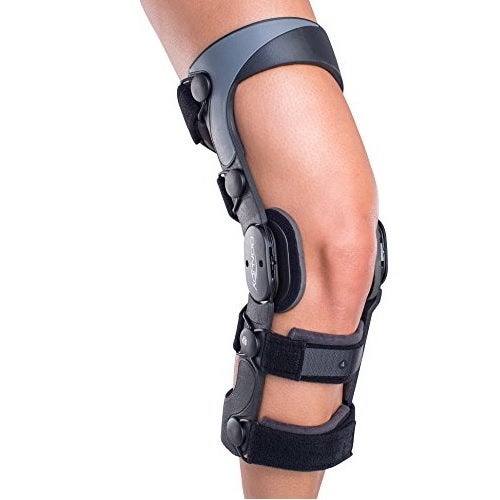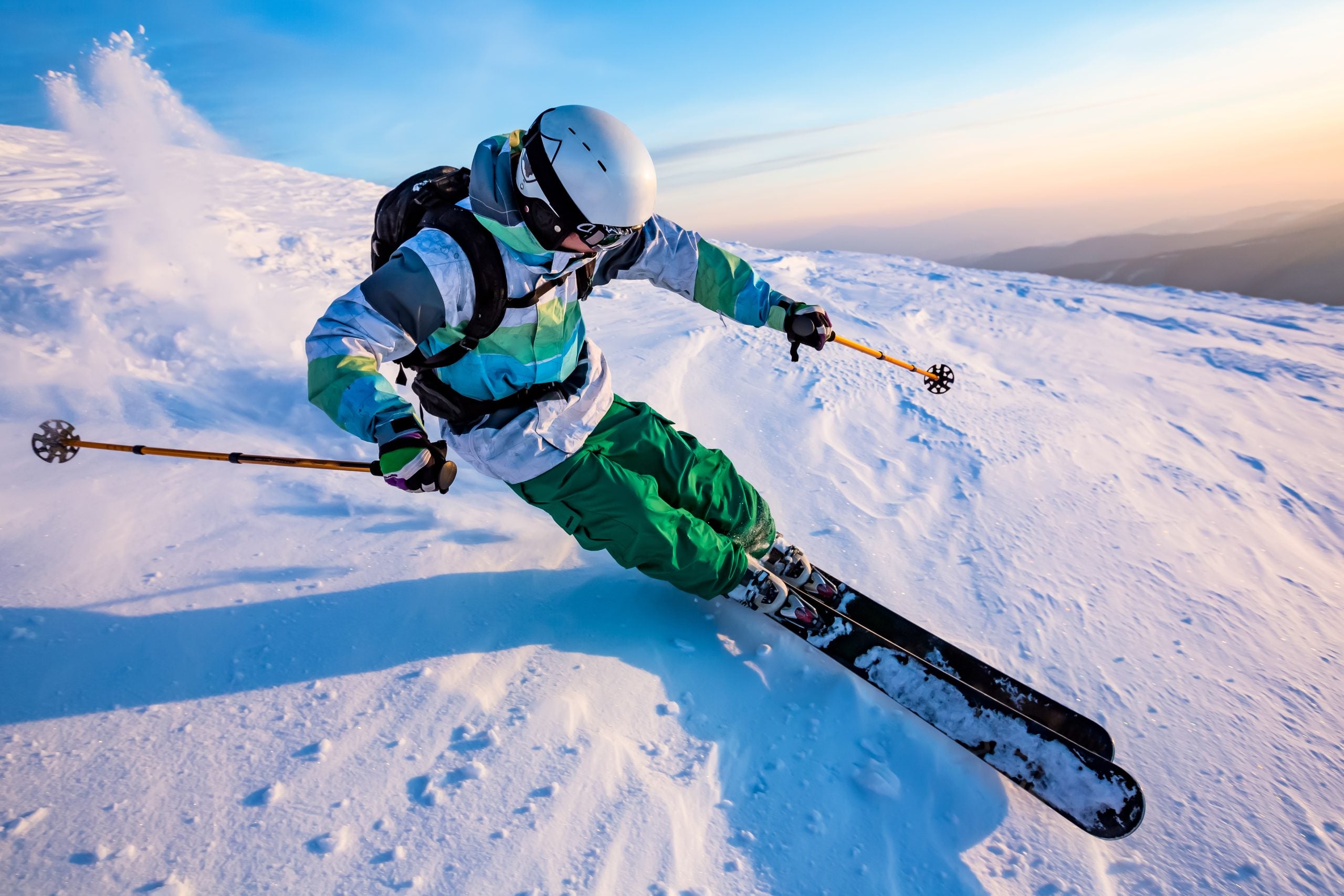
Our Editors independently research, test, and rate what we feel are the best products. We use affiliate links and may receive a small commission on purchases.
If you happen to be a skier with chronic or acute knee problems, you’ll probably end up needing a knee brace for skiing. ACL and MCL tears are controlled by improving skiing equipment, but they’re still all too prevalent. Knee braces can help stabilize your knee and prevent future injuries. Knee braces for skiing are available in a wide range of configurations. For that reason, it’s imperative that you seek the advice and consultation of a trained medical professional before choosing a knee brace. Always seek medical care for an injury – a knee brace is not a permanent solution to avoiding medical care.
Now that we have the disclaimer out of the way, let’s take a look at the knee braces and talk about how to choose the best one for you.
For more of my ski gear recommendations, have a look through these popular Outside Pursuits guide links: Ski Jackets, Ski Pants, Ski Helmets, Gloves.
Quick Answer: The 5 Best Rated Knee Braces For Skiing & Snowboarding
- Shock Doctor 875 Ultra Knee Brace with Bilateral Hinges
- DonJoy Legend SE-4 Knee Support
- McDavid 422 Knee Brace
- DonJoy Playmaker II Knee Support Brace
- Shock Doctor Knee Compression Sleeve with Closed Patella
Now that we’ve briefly looked at the braces, we’ll take the time to go into more detail. Remember, it’s critical to choose the right brace for your injury so always consult a specialist.
Ski Knee Brace Reviews
#1 Shock Doctor 875 Ultra Knee Brace with Bilateral Hinges Review
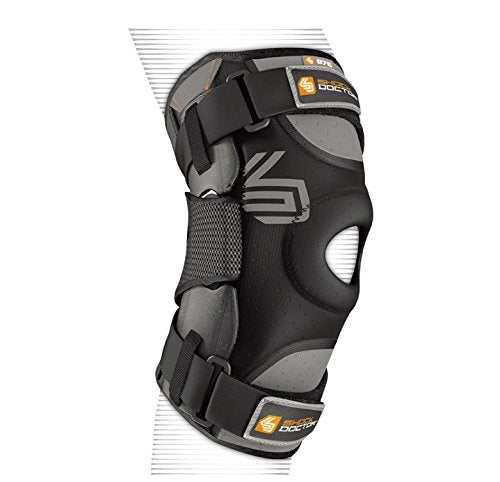 Another open patella design with tons of compression and support is provided by two support hinges. This one is a slip-on design and will definitely be hot during any high-intensity activity.
Another open patella design with tons of compression and support is provided by two support hinges. This one is a slip-on design and will definitely be hot during any high-intensity activity.
Fortunately, they’ve put in N-Tex high airflow neoprene to help minimize the uncomfortable effects of heat and sweat.
With two adjustable straps above and below the knee, you’ll be able to dial in the fit after you’ve measure by the manufacturer’s sizing guide.
Around the knee the X-Fit strap works to stabilize the knee in all the various directions that your complicated knee tendons and ligaments need and offers good knee protection for skiing.
Short video overview of the Shock Doctor knee brace:
Shock Doctor also offers many other levels of knee support in their series of braces. There’s a fairly comprehensive lineup of braces that offer knee protection for skiing for just about any type of injury and they’re all designed around a similar slip on style.
#2 DonJoy Legend SE-4 Knee Support Review
This is a true wrap-around style knee brace with some serious lateral stability. DonJoy has minimized the use of fabrics and neoprene on this hinged knee brace which means you’ll avoid sweaty issues and gain the benefit of a large lateral knee hinge.
Two straps above and below the knee extend far beyond the knee to help give the highest degree of support. It’s low profile design will be great for any high-energy sports, such as skiing where larger devices could get in the way.
This may be the best knee brace for skiing as well as for snowboarding as well, since it offers lots of support that aggressive snowboarders need.
DonJoy intends this knee braces for “moderate to severe” ACL, PCL, MCL, and LCL instability.
#3 McDavid 422 Knee Brace Review
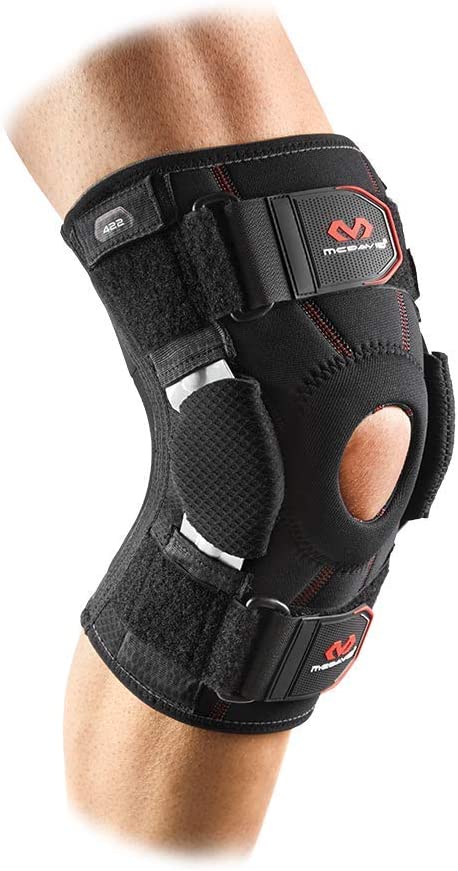
Another articulated ski knee brace for the user with mild lateral instability and hyperextension issues, this one is a slip-on style.
More minimal in design you’re likely to get a little less support from this knee brace than from the DonJoy we looked at above.
One of the good things about a more minimalist design is that you can get some of the benefits of support without the bulk.
If you’re trying to wear this under other clothing without making too much visible, it could be a good solution for low activity levels.
Neoprene construction will quickly build up heat and sweat but the open patella design and overall small form factor mean you won’t have too much to content with.
The articulated steel hinge is well covered to prevent abrasion or irritation and I rate this as a top contender for the best knee support for skiing.
#4 DonJoy Playmaker II Knee Support Brace Review
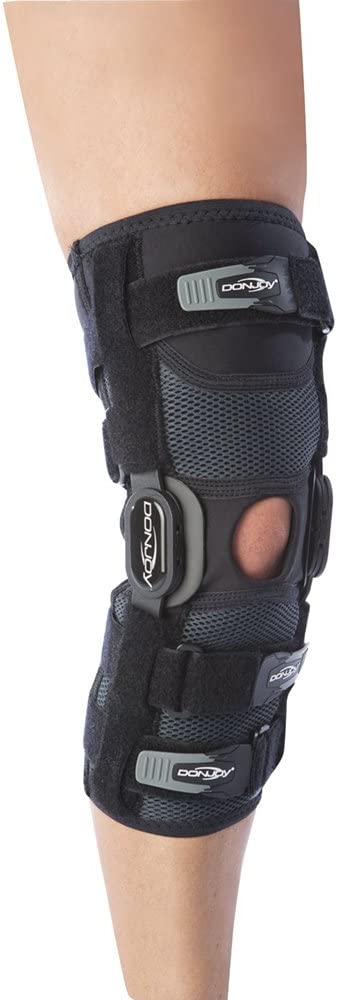
This is a hinged knee brace type support for distinct knee injury types. With an open patella and mild compression mostly provided by the brace staying in place, you’ll also have the benefit of rigid articulated support.
This is a great solution for people with lateral instability problems. DonJoy recommends this brace for those with hyperextension problems, as the brace is made to prevent over extending the knee joint.
It also provides moderate lateral support for ACL, MCL, and LCL injuries.
Video overview of the DonJoy Playmaker II knee brace:
DonJoy strategically included a mixture of nylon, spandex, and other fabrics to maximize wicking and cooling while wearing the brace.
The one downside to this and most knee braces in general, is they have the unfortunate tendency to get sweaty – very sweaty.
#5 Shock Doctor Knee Compression Sleeve Review
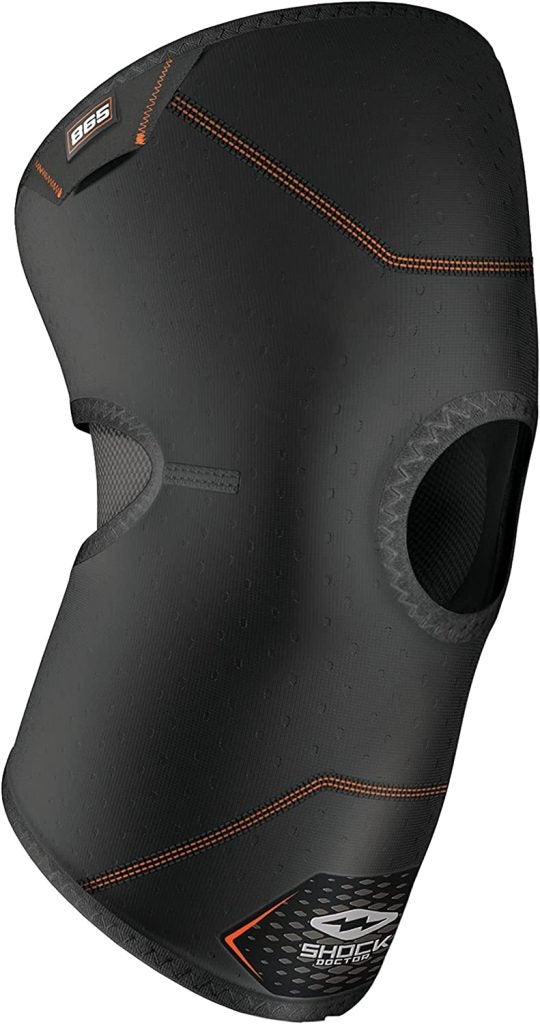
With nice features like the mesh airflow breathable window behind the knee, two thumb tabs for pulling the sleeve into place, and the use of N-Tex moisture wicking fabric for the sleeve this knee support for skiing is minimal but well executed.
Pre-curved design makes this knee support sleeve a great design for those seeking “light support for minor pain, sprains and strains allowing for daily use for an extended period of time”.
Of course, this is not a solution to seeing a doctor and should only be used with the advice of a medical provider. There are no adjustable straps on the knee support so be sure to measure twice and order once.
The only thing keeping this knee support in place is compression support which is meant to be applied above and below the knee as well as across the patella with the closed patella design. It’s also available in an open patella design.
Author’s Expertise / Why You Should Trust Our Reviews
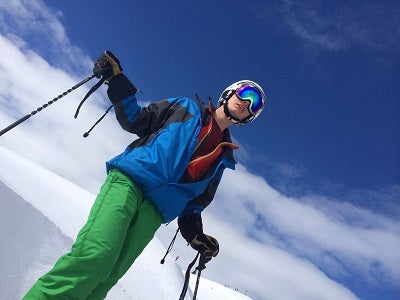
I started writing online for my own outdoor sports blog in 2010. Right out of the gate I landed opportunities to test gear for Road ID, Hydrapak, Wolverine, Helle Knives, Pearl Izumi, and GU Energy. Those were the days when growing a no-name blog was easy. Today niche blogging is a different story.
In 2012 I left Central Wyoming College with a degree in Outdoor Education and Leadership. Soon after, I was on a month-long expedition with the National Outdoor Leadership School’s Outdoor Educator Course which helps would-be outdoor guides ascend from “aspiring” to “inspiring”.
Between here and there I’ve participated in and spoken at length about outdoor pro-deal programs for companies like Patagonia, Smith Optics, Giro, Therm-a-Rest, Platypus, MSR, Columbia, and many more. I still work closely with tons of outdoor gear companies to review and analyze products.
After several seasons of guiding backpacking trips and working as a certified Alpine Ski Instructor at Deer Valley Resort in Park City, UT for several seasons, I had to move on. As any educator will tell you – teaching doesn’t pay the bills very well.
In 2016 I began building my freelance writing career as readers and other bloggers reached out to me for help with technical outdoor sports content strategy for online businesses. Within weeks I was overloaded with requests for freelance writing and my new career blossomed.
2018 saw the launch of Hike With Less, my ultralight backpacking partnership program with Dustin Walker.
How to Choose the Best Knee Brace for Skiing
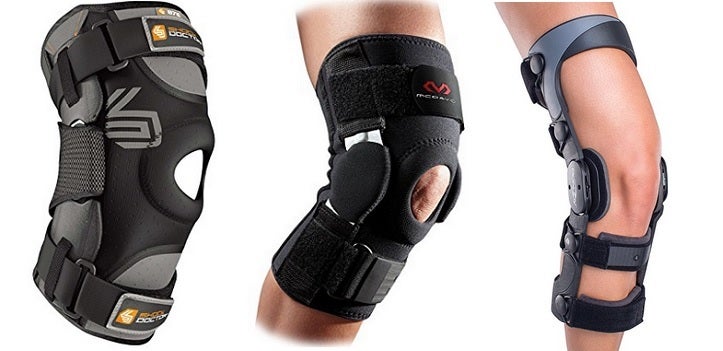
Picking out a knee brace for skiing is a task that should be undertaken with the advice of your doctor. Once you’ve decided to look for a knee brace, you may want to search for the best possible solution. Let’s take a look at what criteria make knee braces work.
Sizing
Every knee brace manufacturer will specify exact sizing for their products. Make sure to go to the manufacturer’s website and get the exact sizing guide with specification on how to measure yourself.
To find a suitable knee brace for skiing, Many makers will require above knee, below knee, and around the knee measurements. It’s always annoying to have to return products multiple times – this will ensure you’ve got the best measurements for the job.
Open Patella vs Closed
Knee support comes in two main flavors: open or closed patella. Each of these is specifically useful for certain knee injuries and you’ll want to double-check with your doctor before deciding.
To keep it simple, some knee injuries are best supported by having pressure applied across the patella. In other injuries, having extra pressure on the patella can actually further damage or impede the healing of the knee.
Without consulting a doctor, it’s hard to choose the appropriate solution.
Slip On vs Wrap Around Knee Braces for Skiing
If you walk into CVS and buy a $20 ACE knee brace, they’re usually a slip-on neoprene. This was my choice for solving my knee injury problem when I was hiking the Appalachian Trail (hint: it didn’t work).
Slip-on braces usually fit a certain size range (S, M, L) and have some small amount of adjustability.
Wrap around braces are more common from prescription solutions to knee problems. Think: Forrest Gump. While I’ve never had one of these, you’ll definitely want to consult a specialist before considering this option.
These are made to solve specific instability issues and, unless you’re a trained specialist, it’s unlikely you’ll be able to choose the best option for yourself.
Types of Knee Braces for Skiing
There are a few general categories of knee braces that cover the majority of knee problems. Let’s briefly look at which types are available to you!
Knee sleeves – are sized slip on braces which usually offer very mild support and compression for injuries.
Knee stabilizers – usually feature steel or rigid supports on both sides of knee for more advanced support.
Hinged knee braces – use two sleeves above and below the knee to attach an articulated lateral support system around your knee.
FAQ For Knee Braces for Skiing
Q: Do knee braces help with all knee problems?
A: That’s a negative. There are many different issues that can arise with your knees and braces don’t help with everything.
Problems could be related to muscle, tendon, ligament, or bone (and probably other stuff I don’t know about). You’ll be glad to know, however, that with some help with specialist doctors and specialized products you can find a knee brace for almost every issue.
Knee braces may be designed to protect the knee during sports with potential for impact.
Compression sleeves (or braces) can be used for pain and support.
Functional braces try to simply support a recovered knee during future activities.
Other braces are meant to help keep the knee in line to prevent issues from ever occurring.
Q: If I start feeling pain, should I push through or take it easy?
A: First of all, I’m not a doctor. However, in all my professional ski training and previous emergency medical training (I used to be a Wilderness EMT), athletic injuries always call for rest.
No matter who I’ve ever talked to or been trained by, the standard prevention is to stop and rest when moderate pain sets in. After rest, you can get back to your favorite sport – skiing!
Remember that if you experience a crash, wipeout, or severe injury you can always go to the ski patrol. They’re trained medical professionals and can assess the true extent of any real damage to your knee. They’ll let you know if you need further medical help.
Q: What is an ACL injury?
A: The anterior cruciate ligament, or ACL, is one of the many support structures that help hold your knee joint in place. Unfortunately, the ACL is particularly susceptible to injury, especially in skiing falls.
Why? Well, again, I’m not a doctor but as I understand it, the problem goes like this:
- The skier begins to fall and the knee bends
- Because of the ski and boot, the lower leg is trapped
- The knee reaches maximum (or near max) bend
- The skier then begins to tumble sideways
- The already stressed knee takes a lateral torsion force because of the length and rigidity of the ski
- The ACL becomes over-stressed and sustains an injury
Fortunately, ACL injuries are less common now, thanks to DIN settings on modern alpine ski bindings. Make sure to get your bindings adjusted by a professional and be honest about your height, weight, and skill when having them set your ski bindings – these are very important to keep you safe!
Q: Can I fly with my knee brace?
A: According to the TSA you can, in fact, pack your knee brace or wear it.
When going through security, however, they may make you take off the brace for inspection. As far as boarding the plane, though, you’re free to check it or carry it in your carry on if you don’t want to wear it.
Q: How can I keep my knee brace warmer?
A: I’ve heard from other skiers with braces that they can be chilly to wear!
But, how can you keep that knee brace comfortable all day? Let’s get a couple of suggestions going.
- Wear a sleeve over the brace
- Wear the brace over a thin base layer of clothing
- Use ski pants with leg vents and keep the vent closed on the leg with the brace
Now, these are all tips for trying to keep a rigid knee brace warmer during the day. Many of you may not have that problem at all.
Maybe you just have bone-cold knees from a day of skiing? In that case, you may want to look into lightweight compression sleeves for your knees. These help with warmth and flexibility for some people.
Conclusion
As we’ve mentioned, knee braces are not a replacement for seeking medical advice from a trained professional.
When you’ve gotten proper care for your injury, using a brace as part of regular prevention and maintenance on existing injuries truly can help prevent worsening and development of new acute injuries.
For many skiers, basketball players, and top athletes, wearing some form of knee support is a critical part of everyday life. There are tons of options available and choosing the correct one is critical to not only help heal and prevent injuries, but to avoid exacerbating existing problems.
We all work hard to keep our bodies in great condition – be sure to invest in your continued health and wellness!
How We Researched
To come up with the top knee braces for skiing we researched a variety of sources for reviews such as REI, Backcountry, Moosejaw, EVO along with our own personal experience.
We also consulted online magazines for product research and reviews to get as much unbiased information as we could. To help weed out fake reviews we used Fakespot.com to make sure we only looked at genuine reviews.
With so much quality gear available, we had to narrow it down based on what we felt were the best options were for the price. The author, Casey Fiedler was a full time ski instructor for Park City and The Canyons in Utah.
To help narrow down the selection he used his personal experience along with recommendations from fellow ski instructors.
After extensive research, we came up with our list to help you choose the right one for you.
I hope this guide was helpful for finding a good ski knee brace to fit your needs. If you want to comment or recommend a brace I didn’t include, please use my contact form to get in touch.
Have fun and be safe out there!

